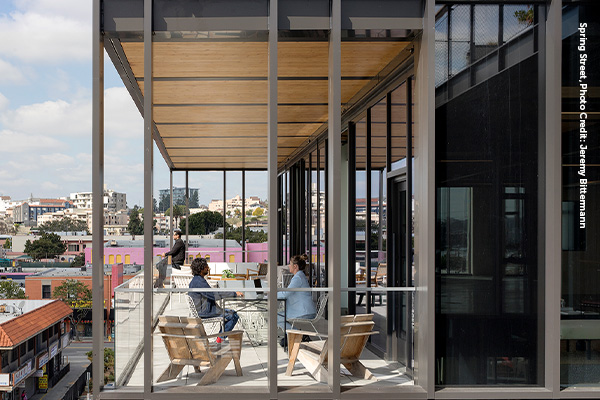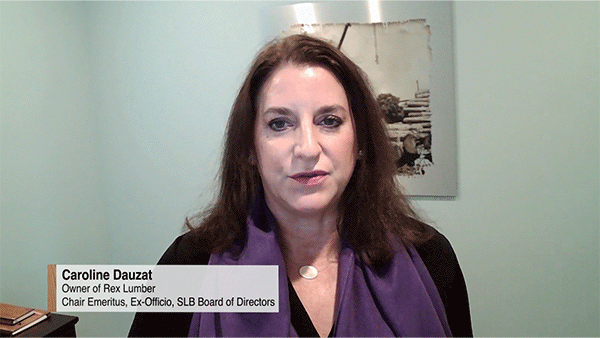HIGHLIGHTS
PROGRAM UPDATES
In 2027 Codes, the AWC Defends and Grows Opportunities for Wood WoodWorks Inspires Design Teams and Developers With Built Wood Projects SLB Education’s VR Experience Puts Students Into Mass Timber Construction—No Hard Hat Required College of Architecture Pavilion Serves as a Learning Lab for Wood ConstructionINDUSTRY RESOUCES
Virginia Tech's Monthly Housing ReportProgram Updates
In 2027 Codes, the AWC Defends and Grows Opportunities for Wood
The International Code Council’s I-codes form the basis for building safety codes in all 50 U.S. states, so ensuring the codes remain receptive and favorable to wood is a major priority. The current 2027 I-code development process began last year with the Group A cycle and will continue through 2026. During the Group A phase, the AWC achieved critical wins for the lumber industry, including successfully gaining approval to have the 2024 Fire Design (FDS) Specification for Wood Construction referenced in the 2027 I-codes.
In 2025, the AWC’s codes team is continuing its engagement through the Group B process. In this Group B cycle, the concrete, masonry, and steel industries are trying to roll back the allowance for 100% exposed mass timber ceilings in Type IV-B buildings first introduced in the 2024 IBC. The AWC moved quickly to review the proposal and coordinate with key allies ahead of the recent April hearings. The change proposal was disapproved. This favorable action also generated significant feedback concurring with AWC analysis that the attempted roll-back of exposed ceilings was not supported by the referenced test reports.
Coordinated through the AWC’s Subcommittee on Codes and Product Acceptance, the AWC’s work in I-code development is critical to ensuring broad regulatory acceptance of wood products and ensuring model codes reflect the latest available information on safe and appropriate wood use.
WoodWorks Inspires Design Teams and Developers With Built Wood Projects
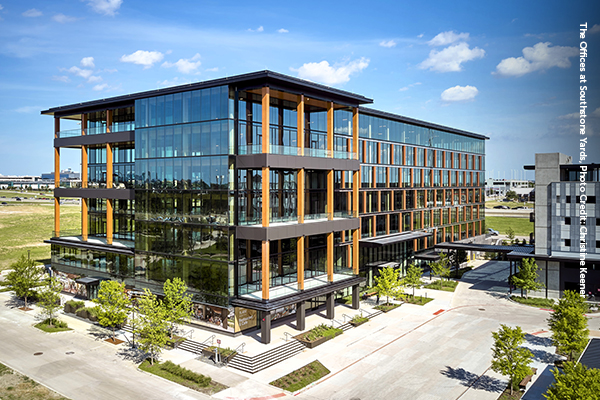
Combined with education and project support, having people experience a wood building firsthand is a key tactic WoodWorks uses to inspire developers and building designers to pursue their own wood project.
- The Regional Director (RD) for Texas recently hosted a seminar at The Offices at Southstone Yards, a 6-over-1 speculative project now fully leased to Toyota. This was the developer’s first use of mass timber, and WoodWorks provided extensive support. The event attracted 52 design and construction professionals interested in learning how to realize mass timber’s benefits.
- The RD for Georgia partnered with Jamestown for a presentation about smart communities, followed by a tour of Jamestown’s 619 Ponce project in Atlanta. The event pulled in 55 attendees and led to a lunch-and-learn with a developer who wants to discuss a hotel project.
- WoodWorks hosted a tour of a mass timber–steel hybrid project for 12 members of ULI Idaho and the state’s real estate community. The architect, general contractor, mass timber installer, and a WoodWorks RD shared their perspectives to help attendees better understand this building type.
- The RD for Northern California hosted a sold-out tour of the University of California–Berkeley’s first mass timber building on campus, targeting the invitations to developers and large tech companies. The project, which has three- and five-story wings, will house more than 10% of general assignment classrooms, introducing a new generation of students to the benefits of wood education buildings.
WoodWorks has found success offering a variety of educational opportunities that give practitioners different levels of engagement with its team—from national webinars to regional seminars, tours, third-party speaking engagements, and on-demand learning. During Q1, WoodWorks provided 22,480 education hours through 88 events.
SLB Education’s VR Experience Puts Students Into Mass Timber Construction—No Hard Hat Required
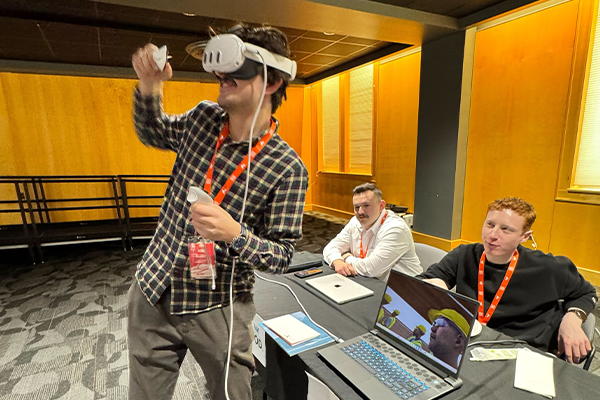
Architecture students from programs across the Pacific Northwest test‑drove the SLB’s new virtual‑reality learning resource at the recent American Institute of Architecture Students West Quad Conference hosted by the University of Idaho. The immersive tool drops users into full‑scale mass‑timber buildings, complete with sweeping atriums, connection close‑ups, and narrated insights on product fabrication and on‑site assembly.
The immersive format solves two common barriers faculty cite when introducing timber: limited access to built examples near campus and reduced capacity for student field trips. By bringing the building to the classroom, the module lets instructors weave timber case studies into courses and design studios without adding the logistics and safety challenges of in-person site visits. Early feedback from West Quad participants was enthusiastic: “Students really enjoyed the experience! It was incredibly immersive, offering a firsthand look at mass timber production and assembly and truly elevated our discussions and interest,” said Conner Reakes, AIAS Chapter President at the University of Idaho.
The SLB will provide the experience at the AIAS Midwest and Northeast Quad conferences—hosted by the University of Kansas and the University at Buffalo, respectively—with additional deployments booked for other campuses throughout 2025. The software is preloaded onto cutting-edge devices and loaned to academic partners. Faculty and investors interested in piloting the teaching resource should contact Education Director Reed Kelterborn at rkelterborn@softwoodlumberboard.org.
By turning any classroom into a virtual site visit, the module deepens the SLB’s partnerships with architecture, engineering, and construction management programs and equips the next generation of designers and builders to specify wood with confidence.
College of Architecture Pavilion Serves as a Learning Lab for Wood Construction
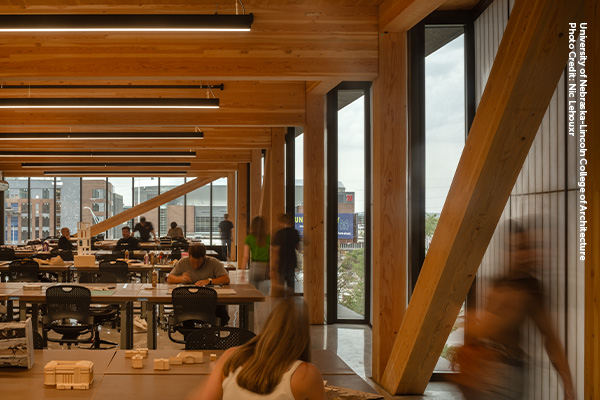
Think Wood’s recent case study of the new mass timber HDR Pavilion at the College of Architecture at the University of Nebraska–Lincoln highlights not only the beauty and carbon reduction of the mass timber structure, but also the building’s value as a teaching tool for students and classes related to mass timber.
“It’s just amazing from a teaching standpoint,” Dean Kevin Van Den Wymelenberg says in Think Wood’s article. “I love the clarity and the integrity because you can just see how all the parts and pieces go together, how sheer is addressed, how lateral bracing [is addressed].” And the positive reception has not just been from the students. “I walked an alum through the building this weekend and he literally hugged the lateral bracing,” he says.
Constructing academic buildings represents a significant opportunity for the lumber industry, with 1.5 billion board feet of annual incremental lumber potential by 2035 if wood reaches 81% market share, according to FEA’s 2026 Construction Outlook. The increased volume would come from a mix of light-frame, mass timber, and steel-timber hybrid construction. Think Wood is highlighting the value of wood construction in both K-12 facilities and university projects, including a recent video featuring Founders Hall at the University of Washington’s Foster School of Business.
Spotlight
The Future Is Under Construction. And It’s Framed With Wood.
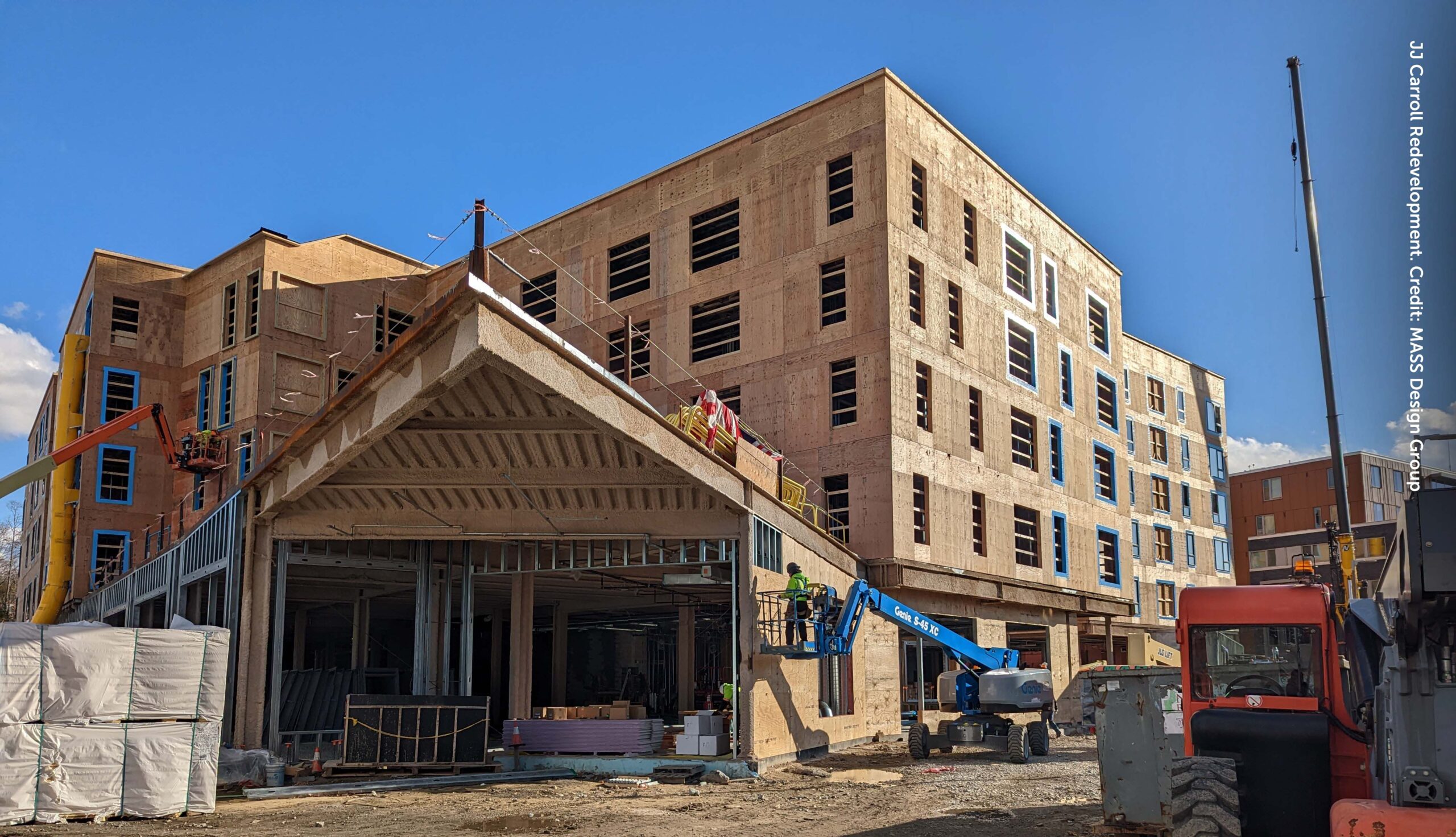
François Robichaud, Partner for Market Research and Engineered Wood Products at Forest Economic Advisors (FEA), is an expert on the market for lumber and wood products and a frequent collaborator with the SLB. In a guest article for the SLB, Robichaud explains why he and his team believe that a transition to increased wood use is well underway.
“With the support of efforts by the Softwood Lumber Board and its funded programs—WoodWorks, the AWC, Think Wood, and SLB Education—light-frame construction is making further inroads into midrise, multifamily construction, and mass timber is transforming the construction industry at an unprecedented pace,” he writes.
In the article, Robichaud takes a deeper look at segments with major potential for growth in lumber’s market share, including midrise multifamily construction with both light-frame and mass timber, education buildings, offices, and warehouses. The SLB has worked closely with FEA to understand and analyze these market opportunities, and it’s developing a vision for growth aligned with the efforts needed to boost lumber’s market share.
Industry Resources
Virginia Tech's Monthly Housing Report
This monthly housing commentary report is a free service of Virginia Tech and is intended to help one gauge future business activity in the U.S. housing market.
March 2025 Reports (released in May 2025)
Part A: March Housing Commentary
Part B: March Economic Conditions


